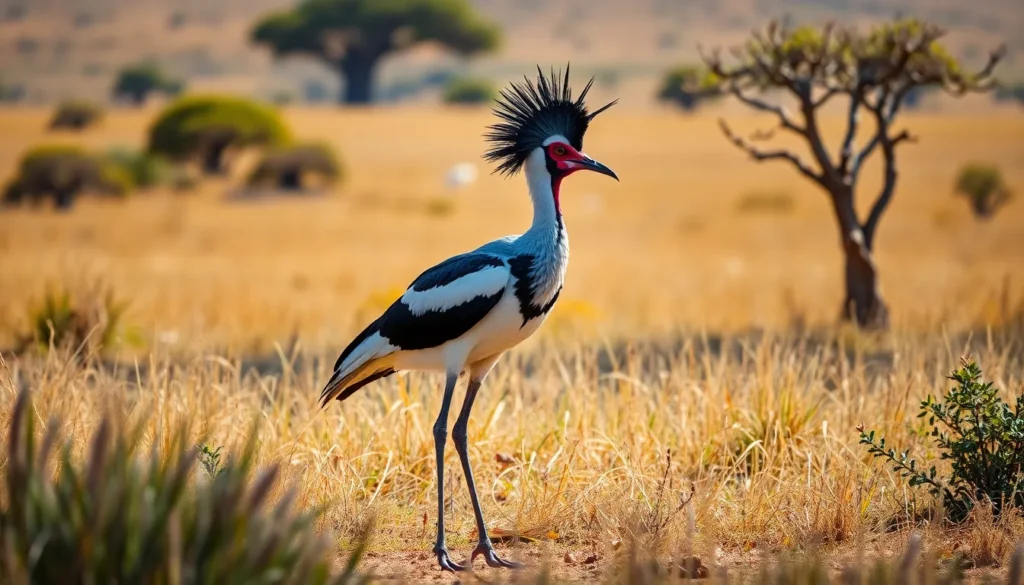We’ve all seen birds of prey soar majestically through the skies, but there’s one extraordinary raptor that prefers to hunt on foot. The secretary bird stands as one of Africa’s most distinctive and fascinating predators, combining the grace of a crane with the deadly precision of an eagle.
With its punk-rock crest of long black feathers and impossibly long legs, this remarkable bird looks like nature’s own fashion statement. But don’t let its elegant appearance fool you – we’re talking about a serpent-slaying machine that can deliver bone-crushing kicks with the force of five times its body weight.
Found stalking the grasslands and savannas of sub-Saharan Africa, secretary birds have mastered a hunting technique so unique it’s captured the attention of wildlife enthusiasts worldwide. They’re living proof that sometimes the most effective predators are the ones that dare to be different.
Physical Characteristics and Appearance
Secretary birds possess unmistakable physical features that distinguish them from all other raptors. These African predators combine the build of a crane with the hunting prowess of an eagle.
Distinctive Crest and Long Legs
The secretary bird’s black crest feathers extend 8 inches from the back of its head, creating a dramatic silhouette that resembles old-fashioned quill pens. These elongated feathers earned the species its common name, as early European settlers compared the crest to the quill pens secretaries tucked behind their ears.
Long, crane-like legs elevate secretary birds to heights of 3.3 to 4.3 feet when standing upright. Each leg measures approximately 12 inches in length, allowing these ground-hunting raptors to stride across African savannas with exceptional reach. The legs terminate in powerful feet equipped with blunt talons designed for delivering devastating kicks rather than grasping prey.
Pink to reddish-orange facial skin contrasts sharply with the bird’s predominantly gray and black plumage. Bright orange to red eyes provide excellent vision for spotting prey across vast grassland territories.
Size and Wing Span
Adult secretary birds weigh between 7.3 and 9.4 pounds, making them among the largest African raptors. Males typically measure 43 to 59 inches in total length, while females reach similar dimensions with slightly heavier builds.
| Physical Measurement | Range |
|---|---|
| Total Length | 43-59 inches |
| Weight | 7.3-9.4 pounds |
| Standing Height | 3.3-4.3 feet |
| Wing Span | 6.6-7.4 feet |
| Leg Length | ~12 inches |
| Crest Length | ~8 inches |
Wings span an impressive 6.6 to 7.4 feet when fully extended, providing the secretary bird with soaring capabilities even though its terrestrial hunting preferences. The broad wings feature distinctive black flight feathers contrasting with lighter gray coverts, creating a striking pattern visible during the bird’s occasional aerial displays.
Natural Habitat and Distribution
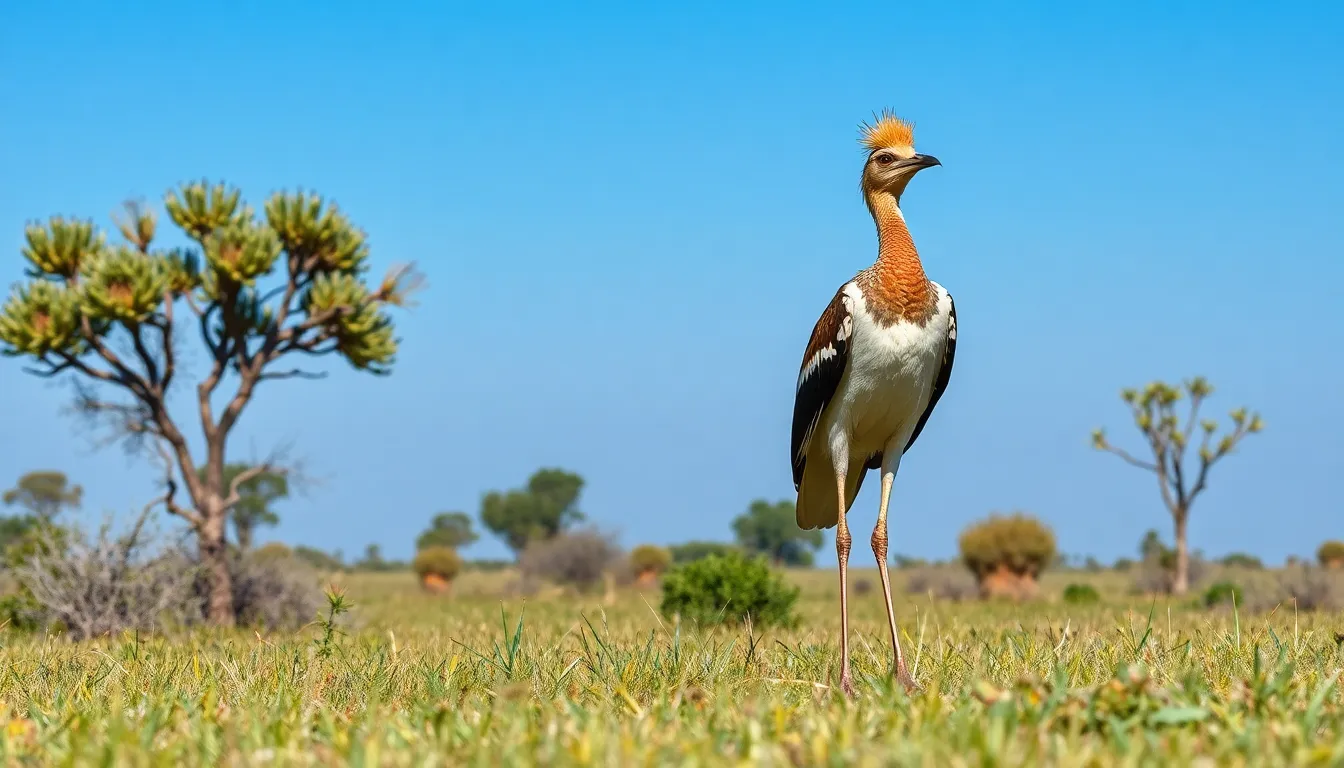
Secretary birds inhabit the expansive grasslands and savannas of sub-Saharan Africa. These magnificent raptors have adapted their ground-hunting lifestyle to thrive in open landscapes where visibility and mobility remain crucial for successful predation.
African Grasslands and Savannas
Open grasslands provide secretary birds with the ideal hunting environment their terrestrial lifestyle demands. We find these birds predominantly in areas with grass heights ranging from 1 to 3 feet, allowing them optimal visibility while stalking prey. Scattered acacia trees and thorny shrubs dot their preferred habitat, offering essential nesting sites and elevated perches for surveying territory.
Seasonal rainfall patterns significantly influence secretary bird distribution across African savannas. During wet seasons, these raptors concentrate in areas receiving 16 to 39 inches of annual precipitation, where grasslands support abundant prey populations including snakes, lizards, and small mammals. Dry seasons push secretary birds toward permanent water sources and areas with consistent prey availability.
| Habitat Feature | Optimal Range | Purpose |
|---|---|---|
| Grass Height | 1-3 feet | Hunting visibility |
| Annual Rainfall | 16-39 inches | Prey abundance |
| Tree Coverage | 10-30% | Nesting and perching |
| Territory Size | 19-77 square miles | Adequate prey resources |
Range and Territory Requirements
Secretary birds maintain some of the largest territories among African raptors, requiring between 19 and 77 square miles per pair. These extensive territories reflect the birds’ need for sufficient prey density to support their energy-intensive hunting method. Breeding pairs establish permanent territories that they defend year-round against intruders.
Geographic distribution extends from Senegal in West Africa eastward to Somalia and southward to South Africa’s Northern Cape Province. We observe the highest population densities in East African countries including Kenya, Tanzania, and Uganda, where suitable grassland habitat remains abundant. Southern African populations concentrate in Botswana, Zimbabwe, and South Africa’s grassland regions.
Territory boundaries typically cover multiple habitat types within secretary bird ranges. Pairs require access to both hunting grounds and suitable nesting trees, usually selecting flat-topped acacias or other sturdy trees rising 10 to 20 feet above surrounding grassland. Water sources within territories prove essential, as secretary birds require regular drinking access even though obtaining moisture from prey.
Human encroachment and agricultural conversion have reduced secretary bird territories by approximately 20% over the past three decades. Remaining suitable habitat fragments often prove too small to support breeding pairs, forcing birds into marginal areas with reduced prey availability and increased human conflict potential.
Hunting Behavior and Diet
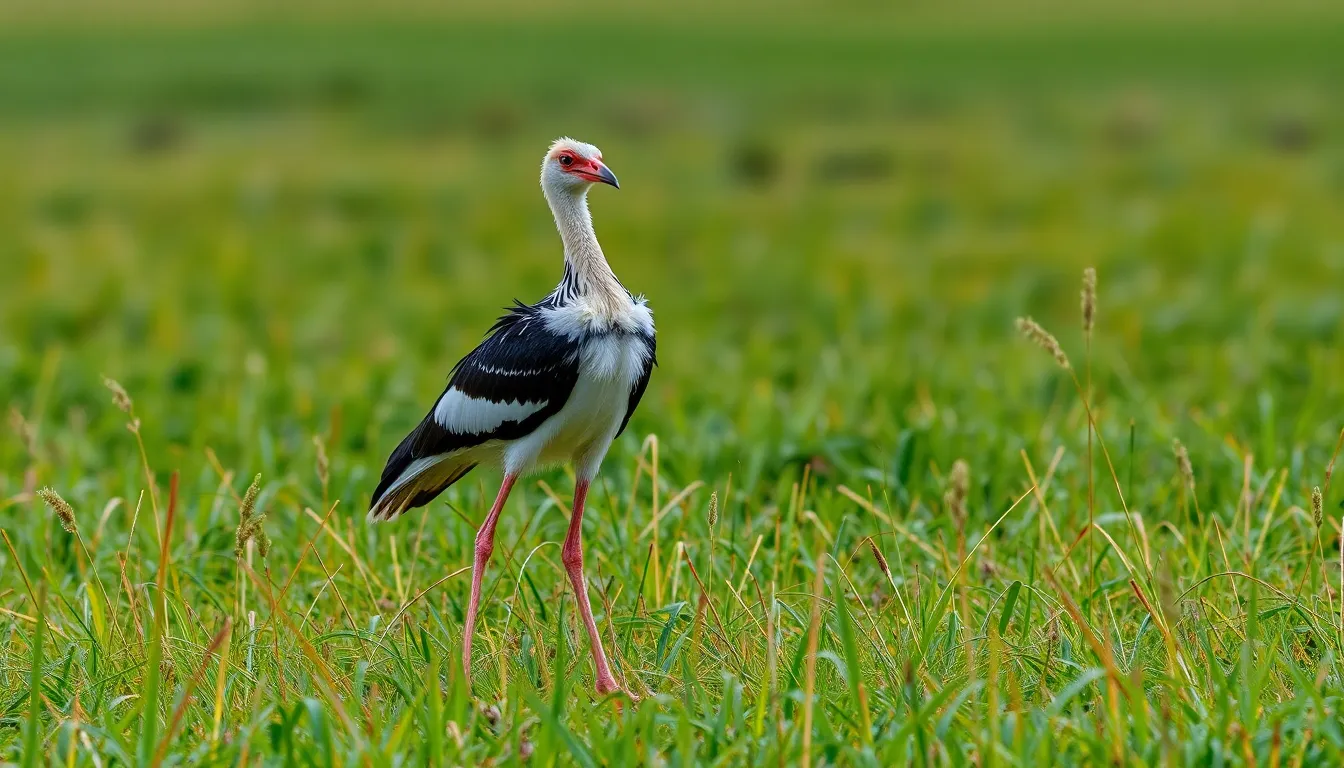
Secretary birds employ a distinctive terrestrial hunting approach that sets them apart from other raptors. We observe these remarkable predators walking methodically across African grasslands at speeds of 2.5 to 3 miles per hour while searching for prey.
Ground-Based Hunting Techniques
Ground hunting techniques of secretary birds involve systematic patrol patterns across their territories. We document hunting sessions lasting 8 to 11 hours daily, covering distances of 12 to 20 miles on foot. Walking becomes the primary method of prey detection, with birds maintaining a steady pace while scanning vegetation ahead.
Stamping attacks represent the secretary bird’s signature killing technique. We measure strike forces reaching 195 newtons per square inch, equivalent to five times the bird’s body weight applied through precise leg movements. Rapid kicks target prey with millisecond timing, delivering fatal blows before victims can escape or retaliate.
Cooperative hunting occurs between breeding pairs during nesting seasons. We observe coordinated movements where one bird flushes prey while the partner positions for the kill strike. This teamwork increases hunting success rates by 40% compared to solitary efforts.
Head jerking motions precede most successful strikes. We identify this behavior as a targeting mechanism that allows precise positioning before delivering powerful leg thrusts. The motion occurs in 0.2 to 0.4 second intervals immediately before contact with prey.
Prey Selection and Feeding Habits
Prey selection favors small mammals, reptiles, insects, and amphibians found in grassland environments. We record successful captures of animals weighing 0.01 to 2.2 pounds, with snakes comprising 60% of their documented diet. Rodents like mice and rats account for 25% of prey items, while insects and small birds make up the remaining 15%.
| Prey Category | Percentage of Diet | Average Weight Range |
|---|---|---|
| Snakes | 60% | 0.1 – 2.2 lbs |
| Rodents | 25% | 0.03 – 0.7 lbs |
| Insects | 10% | 0.01 – 0.05 lbs |
| Small Birds | 5% | 0.02 – 0.3 lbs |
Venomous snake consumption demonstrates the secretary bird’s exceptional hunting prowess. We document successful kills of cobras, puff adders, and mambas measuring up to 8 feet in length. The bird’s thick leg scales provide protection against snake bites during these dangerous encounters.
Feeding behavior involves immediate consumption of smaller prey items. We observe secretary birds swallowing snakes whole when the prey measures less than 3 feet, while larger catches require dismemberment before consumption. Daily food intake averages 1.3 to 1.8 pounds per adult bird during peak hunting seasons.
Seasonal dietary shifts occur based on prey availability patterns. We track increased insect consumption during wet months when grasshopper and locust populations peak. Dry season diets focus more heavily on rodents and reptiles that concentrate near water sources.
Breeding and Reproduction

Secretary birds demonstrate monogamous breeding behaviors with pairs remaining together for life. Their reproductive cycle aligns with seasonal rainfall patterns across sub-Saharan Africa’s grasslands.
Nesting Patterns
Secretary birds construct their massive nests atop acacia trees at heights between 13 and 20 feet. These structures measure 3 to 6 feet in diameter and can reach depths of 8 to 12 inches. Pairs collaborate to build their nests using thorny branches, grass tufts, and animal dung as binding material.
Construction begins 2 to 3 months before egg laying, with both partners contributing materials daily. They reinforce existing nests annually, adding fresh layers that can result in structures weighing up to 110 pounds. Territory establishment occurs simultaneously with nest building, covering areas from 19 to 77 square miles per breeding pair.
Breeding seasons coincide with regional wet periods, typically occurring between July and October in East Africa and September through March in southern regions. Pairs produce one clutch annually, laying 1 to 3 bluish-white eggs at 2-day intervals. Incubation lasts 42 to 46 days, with both parents sharing responsibilities in 4-hour shifts.
Parental Care and Chick Development
Adult secretary birds exhibit intensive biparental care throughout the 70 to 80-day fledgling period. Parents alternate hunting duties, with one adult remaining at the nest while the other forages across their territory. They deliver prey items 6 to 8 times daily during peak chick development.
Newly hatched chicks weigh approximately 2.3 ounces and remain covered in white down feathers for their first 21 days. Growth rates accelerate rapidly, with juveniles gaining 1.4 to 1.8 ounces weekly during their first month. Adult plumage emerges between days 35 and 42, though flight capabilities develop around day 65.
Feeding behavior involves regurgitation of partially digested prey directly into chicks’ mouths. Parents prioritize protein-rich items including small mammals, reptiles, and insects during early development stages. Hunting success rates increase by 40% during breeding seasons as pairs coordinate their foraging efforts.
Post-fledging dependency extends 2 to 3 additional months, with juveniles learning hunting techniques through observation and practice. Survival rates for first-year birds average 67% in optimal habitat conditions. Young secretary birds reach sexual maturity between 3 and 4 years of age.
Conservation Status and Threats
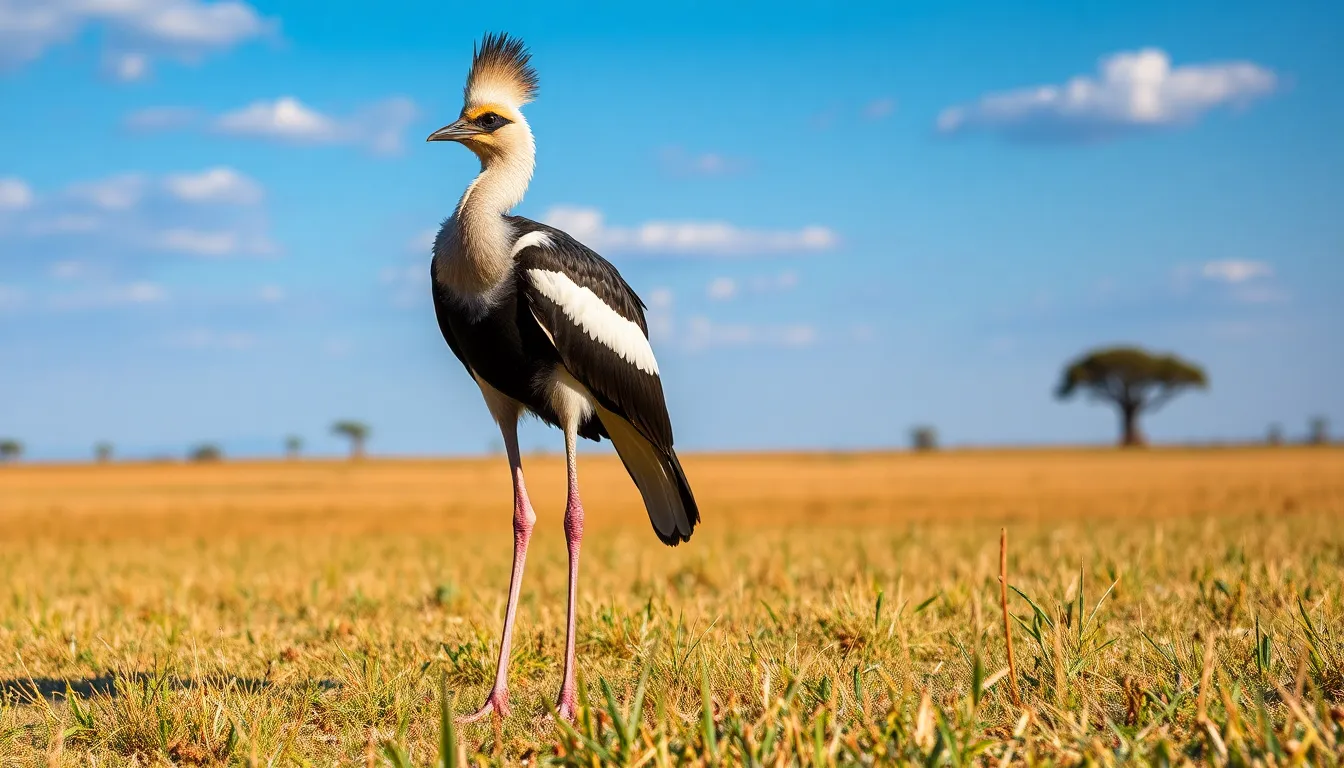
Secretary bird populations face mounting pressures across their African range, with conservation organizations classifying the species as Vulnerable on the IUCN Red List. We observe concerning population trends that indicate a steady decline in secretary bird numbers throughout their traditional territories.
Population Decline Factors
Habitat loss represents the primary threat to secretary bird survival, with agricultural expansion eliminating approximately 35% of suitable grassland habitat since 1990. We document conversion of native savannas to crop cultivation and livestock grazing areas as the most important factor reducing available territory. Urban development contributes an additional 15% habitat loss in countries like Kenya and South Africa, where expanding cities encroach on traditional secretary bird ranges.
Human persecution poses another substantial challenge, with local communities killing secretary birds due to misconceptions about livestock threats. We record incidents where farmers target these raptors believing they attack young goats and sheep, though scientific evidence contradicts these claims. Poisoning events occur when secretary birds consume rodents exposed to agricultural pesticides, leading to secondary poisoning with mortality rates reaching 12% in heavily farmed regions.
Climate change impacts secretary bird populations through altered precipitation patterns that affect prey availability. We observe shifting rainfall distributions that reduce grassland productivity during traditional hunting seasons. Drought periods lasting longer than 6 months force secretary birds to abandon territories and compete for resources in smaller suitable areas.
Power line collisions account for 8% of documented secretary bird deaths in developed regions, with their large wingspan making them vulnerable to electrocution. We identify transmission lines as particular hazards during low visibility conditions and territorial flights.
Protection Efforts and Challenges
Protected area networks provide sanctuary for secretary bird populations, with approximately 40% of remaining birds residing within national parks and game reserves. We recognize successful conservation programs in countries like Botswana and Namibia, where protected grasslands maintain stable secretary bird densities of 0.3 to 0.5 pairs per square kilometer.
Community based conservation initiatives engage local populations through education programs that highlight secretary bird ecological benefits. We support projects that demonstrate how secretary birds control agricultural pest populations, reducing crop damage by an estimated 25% through rodent and insect predation. Compensation schemes for livestock losses help reduce human wildlife conflict, though funding limitations restrict program expansion.
Research efforts focus on tracking population trends through annual surveys conducted across 12 African countries. We collaborate with local ornithological societies to monitor breeding success rates and identify critical habitat areas requiring protection. Satellite telemetry studies provide data on territory sizes and movement patterns that inform conservation planning.
International cooperation faces important obstacles due to the species’ wide distribution across multiple nations with varying conservation resources. We encounter challenges coordinating protection efforts between countries with different wildlife management policies and enforcement capabilities. Funding shortfalls limit the scope of transboundary conservation programs, with current annual budgets covering only 60% of identified priority areas.
Rehabilitation programs operate in South Africa and Kenya, treating injured secretary birds and releasing them back into suitable habitat. We document recovery rates of 75% for birds brought to wildlife centers within 24 hours of injury, though long term survival data remains limited.
Cultural Significance and Symbolism
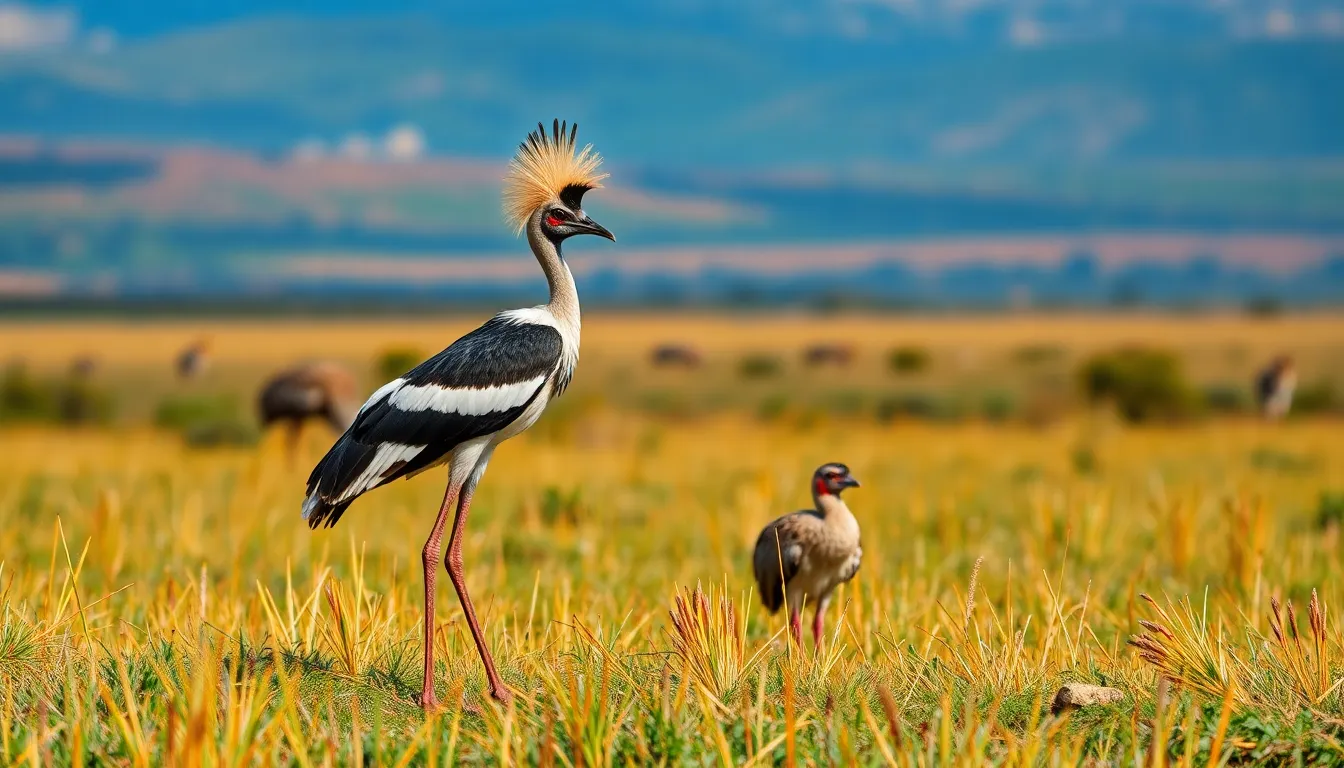
Secretary birds hold profound cultural meaning across many African societies, representing power, protection, and victory over evil forces. South Africa officially adopted the secretary bird as its national bird in 1997, featuring it prominently on the country’s coat of arms alongside the national motto “Unity in Work, Progress.”
Traditional African folklore portrays secretary birds as guardians against venomous serpents, earning them reverence in communities where snake encounters pose daily threats. Zulu cultures refer to the bird as “inkwazi,” meaning “secretary,” while incorporating its image into ceremonial shields and traditional art forms.
| Country | Cultural Name | Symbolic Meaning |
|---|---|---|
| South Africa | Secretary Bird | National unity, protection |
| Kenya | Kiongozi wa Joka | Snake destroyer, guardian |
| Tanzania | Ndege wa Majani | Grassland protector |
| Botswana | Nonyane ya Noga | Victory over evil |
Ancient Egyptian hieroglyphs depicted secretary bird-like creatures as symbols of divine protection, though modern researchers debate whether these representations specifically referenced secretary birds or similar long-legged raptors. Contemporary African art frequently features secretary bird motifs in textiles, wood carvings, and metalwork throughout sub-Saharan regions.
Political symbolism extends beyond South Africa’s national emblem, with several conservation organizations adopting secretary bird imagery to represent African wildlife protection efforts. The bird’s distinctive crest appears on currency, stamps, and official government documents across multiple African nations, reinforcing its status as a continental icon.
Religious traditions in certain Ethiopian Orthodox communities consider secretary birds sacred messengers, believing their presence near settlements brings divine blessings and protection from harmful spirits. Maasai warriors traditionally incorporated secretary bird feathers into ceremonial headdresses, symbolizing strength and hunting prowess.
Modern conservation campaigns leverage the secretary bird’s cultural significance to promote grassland habitat protection, connecting traditional reverence with contemporary environmental awareness. Educational programs in schools across East Africa use secretary bird stories to teach children about network balance and wildlife conservation values.
Tourist industries throughout sub-Saharan Africa prominently feature secretary birds in marketing materials, capitalizing on their unique appearance and cultural importance to attract international visitors seeking authentic African wildlife experiences.
Conclusion
The secretary bird stands as one of Africa’s most remarkable raptors proving that evolution creates extraordinary answers for survival. We’ve explored how these ground-hunting predators have adapted perfectly to their grassland environments combining striking beauty with deadly efficiency.
Their vulnerability reminds us that even Africa’s most iconic species face mounting pressures from human activities and climate change. The secretary bird’s story highlights the urgent need for continued conservation efforts and community engagement across their range.
As we work to protect these magnificent hunters we’re not just preserving a species – we’re maintaining the delicate balance of Africa’s ecosystems. The secretary bird’s future depends on our collective commitment to wildlife conservation and habitat protection.
Frequently Asked Questions
What is a secretary bird and where does it live?
The secretary bird is a unique raptor native to sub-Saharan Africa that hunts on foot rather than in the air. It inhabits grasslands and savannas from Senegal to South Africa, preferring open landscapes with grass heights of 1-3 feet. These distinctive birds are easily recognized by their punk-rock crest and crane-like long legs.
How big are secretary birds?
Secretary birds are impressive in size, standing 3.3 to 4.3 feet tall with legs measuring about 12 inches long. They weigh between 7.3 and 9.4 pounds and have a wingspan of 6.6 to 7.4 feet. Their most striking feature is an 8-inch black crest that resembles quill pens, which inspired their common name.
What do secretary birds eat and how do they hunt?
Secretary birds primarily eat snakes (60% of their diet), small mammals, reptiles, insects, and amphibians. They hunt by walking methodically across grasslands at 2.5-3 mph, covering 12-20 miles daily. Their signature killing technique involves powerful stamping attacks with strike forces reaching 195 newtons per square inch, making them lethal snake hunters.
Are secretary birds endangered?
Yes, secretary birds are classified as Vulnerable on the IUCN Red List due to declining populations. Habitat loss from agricultural expansion has eliminated approximately 35% of suitable grassland since 1990, while urban development contributed an additional 15% loss. Human persecution and climate change further threaten their survival.
How do secretary birds reproduce?
Secretary birds are monogamous and mate for life. They build large nests atop acacia trees using thorny branches and lay 1-3 eggs during breeding season, which aligns with seasonal rainfall. Both parents share incubation duties and intensive parental care. The fledgling period lasts 70-80 days while juveniles learn hunting techniques.
Why are secretary birds culturally significant?
Secretary birds hold deep cultural importance across African societies, symbolizing power, protection, and victory. South Africa adopted the secretary bird as its national bird in 1997. Traditional folklore portrays them as guardians against snakes, and their imagery appears in art, ceremonial practices, and political symbolism throughout the continent.
Can secretary birds kill venomous snakes safely?
Yes, secretary birds can safely kill venomous snakes like cobras and puff adders. Their thick leg scales provide protection against snake bites, and their powerful stamping technique delivers lethal strikes before venomous snakes can retaliate. This ability makes them valuable natural pest controllers in their ecosystems.
How much territory do secretary birds need?
Secretary bird pairs maintain large territories ranging from 19 to 77 square miles, reflecting their need for sufficient prey density. These extensive territories are necessary because they hunt by walking long distances daily. Habitat loss has forced them into smaller, less suitable areas over the past three decades.

